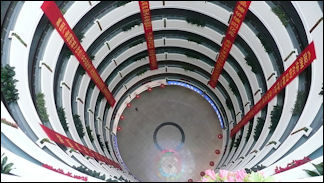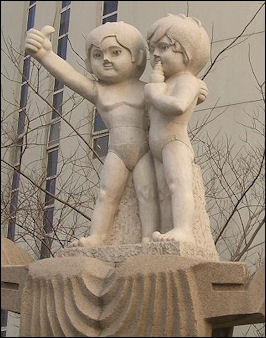ELECTRONICS INDUSTRIES IN CHINA
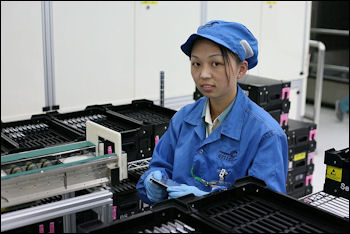
Seagate tests drives
China is one of the world's largest producer of electronics. Chinese companies make computers, scanners, computer disks and silicon chips. As of 2005, China produced two thirds of the world’s television sets and DVD players and other electronic gadgets. China expected produced 98 million desktop and laptop computers in 2006, with of most them produced for export. Chinese producers are also making stuff for buyers at home. Between 1994 and 2000, the share of domestic television makers rose from 30 percent to more than 80 percent. In 2000, Chinese companies produced 43 million televisions.
In 2004, China overtook the United States as world’s biggest supplier of information technology goods. A report by the OECD showed that China’s exports of information and communication technology — including laptop computers, cell phones and digital camera — increased by more 46 percent to $180 billion in 2004 from the previous year. By contrast the U.S. exported $149 billion, a 12 percent increase from 2003. In the late 2000s, China produced more laptop computers, computer parts, cell phones and other communications goods than the United States or any other country. It produces three out of every four photocopiers in the world and two thirds of the watches. Technology exports such as cell phones and computers account for 27 percent of China’s exports.
Global PC market share (percentage in 2009): 1) Hewlett Packard, U.S. (19.7 percent); 2) Dell, U.S. (12.6 percent); 3) Acer, Taiwan (12.6 percent); 4) Lenovo, China (8.2 percent); 5) Toshiba, Japan (5.2 percent); 6) Asus, Taiwan (4.1 percent); 7) Apple, U.S. (3.7 percent); 8) Samsung, South Korea (2.1 percent); 9) Sony, Japan (2.1 percent); 10) Fujitsu, Japan (1.8 percent); 11) Founder, China (1.2 percent); 12) NEC, Japan (0.9 percent); 13) Other (25.9 percent). [Source: IDV Japan Data]
The electronic market is very competitive and profits margins are slim. The price of televisions, for example, dropped one fifth every year between 1996 and 2000. In addition most of the profits made electronic items made in China for foreign companies end up outside of China, mostly with the foreign companies and retailers. Of the $280 manufacturing costs for the Apple iPhone, for example, which is assembled in China under the guidance of of the Taiwanese company Hon Hai, less than five percent actually stays in China.
Chinese production strategies have changed the way the electronics industry operates. Wolf Corrigan of the consulting group LSI Logistics, told the New York Times: “Typically a new technology will be released at $1,000 in Japan and it would take two years to drop below $1,000 and make it to the U.S. and Europe and take a total of five to seven years to reach the mass market. As features were added, prices rose. Now China’s low labor costs and the vastness of it population are combining to bring bargain electronics into homes in record time. Chinese companies build sophisticated goods with components produced locally and rush them by the millions into the huge domestic market. New companies arrive. Competition shrinks the times it take for new products to appears, new features are added while prices are likely to drop Anything to pump up sales.”
RECOMMENDED BOOKS: “Tech Titans of China: How China's Tech Sector Is Challenging the World by Innovating Faster, Working Harder, and Going Global” by Rebecca A. Fannin, Janet Metzger, et al. Amazon.com; “Factory Girls: From Village to City in a Changing China” by Leslie T. Chang, Susan Ericksen, et al. Amazon.com; “The Great U.S.-China Tech War” by Gordon G. Chang, Al Kessel, et al. (2020) Amazon.com; “China's Leap into the Information Age: Innovation and Organization in the Computer Industry” by Qiwen Lu (2000) Amazon.com; “Marketing Dictatorship” by Anne-Marie Brady Amazon.com; “The Xiaomi Way: Customer Engagement Strategies That Built One of the Largest Smartphone Companies in the World” by Li Wanqiang Amazon.com; “The Transpacific Experiment: How China and California Collaborate and Compete for Our Future” by Matt Sheehan Amazon.com; “Dying for an iPhone: Apple, Foxconn, and The Lives of China's Workers” by Jenny Chan , Mark Selden , et al. Amazon.com; “Start with China: How Apple Uses Cheap Labor to Make Billions” by Smith Murphy and Jones O’kelly Amazon.com; “Apple- Foxconn Study” by Bankim Chandra Pandey Amazon.com
Chinese Electronics in the 1980s
In 1987 China's electronics industry was about ten to fifteen years behind those of the industrialized nations. Key problems were the inability to transfer technology from research to production and continued reliance on hand labor. Also, impatience to reach Western standards `sometimes proved counterproductive. For example, instead of buying a complex item such as a microprocessor abroad, China chose to develop its own, at great expense.* [Source: Library of Congress, 1987 *]
In 1985 the electronics industry consisted of approximately 2,400 enterprises, 100 research institutions, 4 institutes of higher learning, and 20 secondary vocational schools. The industry employed some 1.36 million people, including 130,000 technical personnel. Besides the approximately 2,000 types of electronic components and large-scale integrated circuits produced by the industry, it made 400 varieties of electronic machinery, including electronic computers, television broadcast transmitters and receivers, and radar and communications equipment. In the 1980s China made great strides in the production of consumer electronic products such as televisions, radios, and tape recorders.*
Retooling for Higher Value Products in China in the 2000s
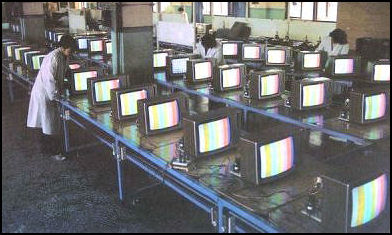
Television factory in the 1980s
In the late 2000s many factories began training their work forces, investing in sophisticated machinery and retooling their factories to make higher-value products. Some companies felt they had no choice but to follow this trend as the rising costs of labor and materials and low selling prices made it hard to make money in cheap-labor industries. Ground zero for this trend is in Shenzhen and Dongguan, former cheap-labor factory centers.
BYD, a Shenzhen-based company that became the world’s second largest battery maker in less than a decade, was even more ambitious. It built a 1.6-million-square-foot assembly plant and has hired Italian-trained car designers to make plug-in hybrid cars. Hasee,a computer maker founded in 2002 and was producing 100,000 laptops a month by 2010. By pouring it resources into research, focusing on innovative computers such as laptops that sold for less than $370 it hoped to be the world’s largest computer maker by 2020.
Chinese companies have expanded into software, biotechnology, medical devices and supercomputers. By 2010 they were developing a passenger jet, several models of automobiles and opening up sophisticated chip plants as Japan and South Korea did before them. Andy Rothman, a longtime China analyst, told the New York Times at that time, “When a country is in its early stages of development, as China was 20 years ago, having an export processing center is good for growth. But there’s a point when that’s no longer appropriate. Now China’s saying, “We don’t want to be the world’s sweatshop for junk any more.”
Factors pushing China’s drive to produce more sophisticated products include the rising value of the yuan, the high cost of labor, labor shortages, new labor laws that mandate overtime and severance pay, the movement of workers to factories in the interior, high fuel and material costs, higher shipping costs, criticism over shoddy products and safety, efforts to clean up the environment — all of which make it hard to make money off cheap products and thus pushes companies to modernize and become more productive and efficient.
In its favor China possesses an array of ambitious entrepreneurs, fiercely competitive domestic markets and hundreds of thousands of highly trained engineers. The government drove the process forward by tightening pollution regulations and encouraging companies to invest in expensive new machinery, often providing the money from state-owned banks to finance such upgrades. Beijing discouraged the establishment of cheap-labor factories in southern China by ending tax breaks there.
Chinese Electronic Companies
Major Chinese electronics companies include BOE, Changhong, DJI, Haier, Hisense, Huawei, Konka, Lenovo , Meizu, Panda Electronics, Skyworth, SVA, TCL, Xiaomi, Oppo and ZTE. Xiamen Republic Electronic Co. was known primarily as a maker of DVD player. Konka makes televisions that are sold in the United States.
TCL was once called the Chinese Sony. The largest publicly traded electronic maker in China in the 2000s, it combined with Thomson to make televisions and DVD machines and became the world’s largest television maker, producing 20 million televisions a year. TCL bought German television maker Schneider Electronics AG in 2002 and made handsets with Alcatel SA.
BOE Technology is a major monitor and computer screen maker. In 2003, it became a global competitor after purchasing the display business of South Korea’s troubled Hynix semiconductors for $38 million.
Hisesnse is a television maker with global ambitions. Largely owned by the Chinese government, it hopes to increase profits and sales by increasing the scale of production to get better deals on raw materials and establish a brand which consumers would pay high prices to get. Among its achievement have been setting up a factory in Hungary in a matter of months to supply the European market. It also has factories in South Africa, Algeria, Iran and Pakistan. Hinsense began as the Qingdai City Number Two Radio factory in 1969 as a manufacturer of AM radios with 30 employees who task at that time was to deliver the message of class struggle during the Cultural Revolution. A year later it made its first black and white television . By 1970 it was producing 6,000 televisions a year. In 1989 ut changed its name to Qindao Hisense Group. In 1997 shares were sold on the Shanghai Stock exchange. In 2004, it employed 10,000 people and had annual sales of $2.75 billion. At the Hisense factory in Qingdao in the 2000s, workers who are paid $100 a month assemble flat panel televisions with screens up to 50 inches under a digital display that records how many televisions they make and how many they need to make to reach that day’s goal.
Sichuan Changhong Electric Co. is China’s No. 1 television exporter and No. 2 television maker. It began as a company that produced radars for the People’s Liberation Army. In 1997 it was the world’s 7th largest television producer. At that time it produced 6 million television sets a year. Their plant at Mianyan in Sichuan alone produces 3,400 television sets a day on 17 assembly lines manned by workers who wear matching blue uniforms and are encouraged to read Chinese classics. Changhong televisions are sold under the Apex name in the United States and are available in Wal-Marts. In December 2004, Changhong announced losses of almost $500 billion, because of declining sales in the United States, accusations of dumping and the failure of ones it largest customer to pay money it owed.
Foreign High Tech Companies in China
Foreign high tech companies are attracted to China by highly skilled, low wage engineers and computer programmers as well as low-cost labor. Microsoft employs engineers that take questions from customers in the United States, South Korea, India and Thailand. Intel, IBM, Oracle, Microsoft and Siemens all have all research facilities n in China. Applied Material, Intel and Hewlett-Packard have set up high tech factories in China. In the city of Wuxi factory compounds with schools, playground and its own power plant makes disk drives and devices called optocouplers in dust-free rooms.
Intel has semi-conductor plant and a state-of-the-art facility with 1,000 researchers in Shanghai and has $375 million assembling plant in Chengdu. first manufacturing plant in Asia. In September 2007 ground was broken on a $2.5 billion Intel chip factory in Dalian. It is Intel’s first manufacturing plant in Asia and represent one of the biggest single investments in China. The plant is slated to open in 2010, and employ 1,200 people.
Cisco, the world’s largest maker of networking equipment, had invested $8.5 billion in China as of 2007 and was planned to spend a total of $16 billion by 2012. The company sells equipment for phone and high-speed wireless services and has stakes in Alibaba.com and Harrier, two of China’s best-known companies. See Internet
Chinese companies make computers for IBM, Dell, Hewlett Packard and other Dell purchased $18 billion worth of computer components from China in 2006, up from $15.7 billion in 2005.
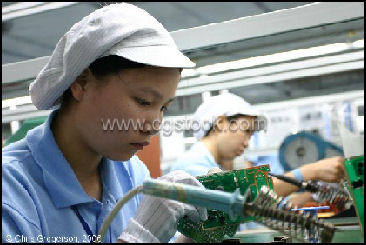
Electronics industry worker Dell is the largest foreign compute maker in China with 10 percent of the market. In September 2007, Del announced that it had made a deal with Gome to sell its computers in their stores. Dell has introduced a low-price computer geared specifiable for rural Chinese.
Chinese companies make cell phones for Motorola, which are sold in China and around the globe. Motorola tripled its outlets to 30,000 in 18 months in the mid 2000s.
In August 2007, a Chinese technology company initiated an effort to buy of only two disk makers left in the United States — Seagate and Western Digital.. Some American government officials objected to the move on national security grounds. In November 2010, China Aviation Industry and General Electric, the world’s biggest jet engine maker, agreed to form a joint venture to sell avionic systems and provide services for aircraft. GE entered the deal in part to get more involved to supplying parts for Chinese-produced aircraft.
Chinese Chips
China is one of the world’s largest chip (semiconductor) maker.s The top chip makers by country by market share (fourth quarter 2021) were: 1) Taiwan (65 percent); 2) South Korea (15 percent); 3) United States (7 percent); 4) China (6 percent); 5) Others (7 percent) China's figure is probably because Some of the chips attributed to Taiwan are made in China. As of 2004, China was the world’s fifth largest seller of chips in terms of volume after the United States, Japan, Taiwan and South Korea. [Source: tecvalue]
In the early 2000s, China was a leader in a low-end chips used by Chinese makers to make things like calculators and clocks. It chips were not as advanced as those produced by Taiwan, South Korea, the United States and Japan but it was catching up fast. Many managers at Chinese chip firms were Taiwanese. China also made advances by imported sophisticated chipmaking machinery that allowed them to make chips and learn to the technology to make such machines.
The United States has complained that in it drive to be a major high-tech manufacturer, China has placed an unfairly high tax on foreign chips and it is developing technical standards that are unique to China. There are worries that once China gets into chip manufacturing in a big way it will produce a global glut, forcing prices to plummet.
In the 2000s, Semiconductors Manufacturing International is China’s largest chipmaker. SAST, Advanced Semiconductor Manufacturing, All Best Technology and Huaxia Semiconductor Manufacturing were two other large Chinese chip makers at that time. In the 2000s, a number of computer chip plants sprung up on the outskirts of Shanghai
Foreign investors into Chinese chips have included Intel, Advanced Micro Services, IBM, NEC, Philips and Toshiba. These companies invested in chips not because they saw chips as a major growth market but because they wanted to be close to their buyers. A wide variety of chips are used in manufactured goods produced in China. China wanted the plants so it doesn’t have to import so many chips. As of 2002, it imported 20 percent of its chips.
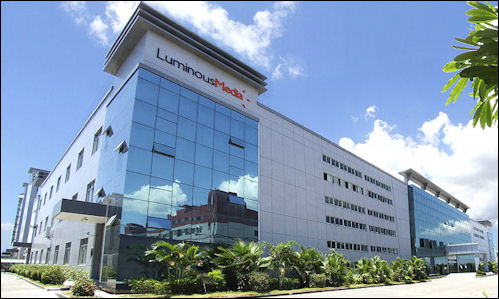
Luminous Media Factory
China’s Largest Chip Makers
1) LONGi Green Energy Technology Co.,Ltd group and Wafer BU are headquartered in Xian, which is located in an area rich in silicon. The company . LONGi mono-crystalline Silicon takes full advantage of this and has been the largest mono-crystalline silicon manufacturer in the world since 2015. At the end of 2018, the production capacity of LONGi Mono-crystalline Silicon has reached 28GW. LONGi had revenues of US$6.6 billion and 526 core technology patents in 2020. [Source: Raveendran, firmsworld.com, April 8, 2021]
2) Semiconductor Manufacturing International Corporation (SMIC) is mainland China’s most advanced and largest foundry,. Headquartered in Shanghai, the company has an international manufacturing and service base and offers China’s broadest technology coverage, and most comprehensive in semiconductor manufacturing services. In the 2000s, SMIC was China’s largest supplier of made-to-order chips and was on course to become the world’s third largest maker of made-to-order chip despite being ordered to pay $175 million to a Taiwanese chip make in a patent dispute.SMIC had revenues of US$4.2 billion in 2020
3 )Jiangsu Changjing Electronics Technology Co., Ltd. is a semiconductor product research and development, design and sales company with independent research and development, sales and service. Established in November 2018 and is headquartered in Nanjing, it specializes diodes, transistors, MOSFETs, LDOs, DC-DCs, frequency devices, power devices, etc., with more than 15,000 product series and models, products are widely used in various consumer and industrial electronic fields. The company was formerly a discrete device division of Jiangsu Changjiang Electronics Technology Co.which was established in 1972 and listed on the Shanghai Stock Exchange.Jiangsu Changjing’s revenues in 2020 were US$3.9 billion,
4) Will Semiconductor Co. (Willsemi) is a semiconductor device and mix-signal IC design house. Established in May 2007 and based in Shanghai Zhangjiang Hi-tech Park, produces protecting devices (TVS,TSS), power devices (MOSFET, SCHOTTKY, transistor), power management IC ( LDO, DC-DC, charger, BL led driver, Flash LED driver) and analog & power switches. The company’s revenues in 2020 were US$2.85 billion,
ZTE
Haier research facility
ZTE (formerly Zhongxing Telecommunications Equipment) is a Chinese technology company manufacturing giant that is partially owned by the Chinese government and sells communications gear in more than 140 countries. Founded in 1985 by Hou Weigui and based in Shenzhen, it specializes in telecommunication and operates carrier networks, terminals, and telecommunication. Its core business is wireless, exchange, optical transmission, data telecommunications gear, telecommunications software, and mobile phones. It also offers video on demand and streaming media. Among its products are mobile phones, smartphones, tablet computers, hardware, software and services to telecommunications service providers and enterprises It primarily sells products under its own name, but it is also an OEM.
ZTE Corp is listed on both the Hong Kong and Shenzhen Stock Exchanges. It was second-biggest telecom equipment vendor by sales as 2013 and is now one of the top five largest smartphone manufacturers in China. ZTE is an international company and has been active deployed 3G and 4G networks in a number of countries around the world. Its chairman is Yin Yimin. The president and executive director is Zhao Xianming.
In 2019, ZTE earned revenuesUS$13.2 billion, with an operating income of US$1.13 billion and net income of US$825 million. The company’s total assets in 2019 were US$21.2 billion and its total equitywas US$5.25 billion. The ownerof ZTE are Zhongxingxin (30.34 percent) and China Aerospace Science and Industry Corporation, an enterpise owned by the Chinese government. ZTE had 68,240 employees in 2018. Its major subsidiaries are Nubia Technology (49.9 percent), ZTEsoft and Zonergy
ZTE and its Chinese rival Huawei, another telecommunications equipment company based in Shenzhen, have had great success selling telecommunications equipment in the developing world. ZTE is very active in India and also has contracts in Lesotho and Ghana.
Controversies Involving ZTE
ZTE allegedly paid tens of millions of dollars in kickbacks in the Philippines in connection with a 2007 contract. Among those charged in connection with the case were former president Gloria Magacapal-Arroyo, her husband and two other former senior officials in her administration. [Source: Andrew Higgins, Washington Post, June 24, 2012]
Andrew Higgins wrote in the Washington Post, “The criminal prosecution, which follows a lengthy investigation into ZTE’s business practices by the Philippine Senate, puts a spotlight on the role played by Chinese companies in extending China’s economic reach around the world but also in straining Beijing’s doctrine of noninterference in the affairs of other states. While insisting that it does not meddle in foreign lands, China keeps getting dragged deep into the affairs of other countries by the pursuit of profit by corporations controlled by or closely tied to the state.
“ZTE is also under scrutiny in Washington, where the House intelligence committee is investigating whether it and another large Chinese company, Huawei Technologies, pose a threat to national security through their equipment sales in the United States. Mitchell Peterson, a spokesman for ZTE in the United States, said the company will be “transparent, candid and cooperative” with the intelligence committee’s inquiry.
“In the North African state of Algeria, a recent corruption case involving ZTE has dented China’s reputation in a country that had been one of its keenest supporters on the continent. There a court found two ZTE executives guilty of “influence peddling” in absentia through the payment of illegal commissions. ZTE has also come under criticism for equipment sales to Iran that opponents of the Islamic regime say allow authorities in Tehran to monitor the phone and Internet communications of dissidents. The Nigerian government, meanwhile, is investigating a $470 million contract awarded to ZTE, complicating China’s efforts to woo Africa’s biggest oil producer.
Haier
Haier Logo in Qingdao Haier is the world’s largest appliance manufacturer. It makes air conditioners, washing machines, refrigerators and other household appliances. Based in the eastern Chinese port city of Qindao in Shandong Province and founded in 1984 , it sells products in more than 160 countries and grew incredibly fast in the 2000s because of its cheap prices and ability to undersell competitors. The company was is valued at $10 billion in 2009 and at the time was quickly making a name for itself as a producer of quality low-price large appliances. in 2013, Haier employed more than 80,000 people in more than 100 countries and territories. As of December 2011, its group sales were US$22.9 billion according to the Yomiuri Shimbun.
Haier Inc. is one China’s best known brands. It is the leading appliance maker in China, one of leading appliance maker in the world and one the world largest maker of small refrigerators like those found in hotel and college dormitory rooms. Haier was the number one brand globally in major appliances for 10 consecutive years from 2009 to 2018 according to Euromonitor,. The Haier brand was also recognized by BrandZ in 2019 as the most valuable IoT (Internet of Things) ecosystem brand in the world with a brand value of $16.3 billion. In 2019, Haier Smart Home ranked 448 on Fortune's Global 500 list with a revenue of $27.7 billion. Haier subsidiaries include GE Appliances (U.S. majority 90 percent), Hotpoint (U.S.), Hoover (Europe), Candy, Fisher & Paykel and Sanyo (South East Asia). [Source: Wikipedia]
Haier was nearly in bankrupt in 1984 but turned things around. It began exporting refrigerators in 1992 and captured a quarter of the small refrigerator market in the United States by the early 2000s. It had annual sales of $5 billion in 2000 and has 13 factories (including one in South Carolina) and 30,000 employees (more than one tenth in research and development).
Haier is known for its innovative products. In China it sells a clothes washer with an attachment that kneads noodle dough, a clothes washer capable of cleaning potatoes and a television set that "prevents near-sightedness" if viewers get too close. The one that kneads noodle dough has been a big seller for Chinese.
Japanese companies such as Sanyo outsource their domestic refrigerator production to Haier. In 2010, Haier launched a major marketing offensive in Japan, the home of many of its competitors. It hired Japanese technical experts for advise, designed products specifically for the Japanese market and sold its products for 20 percent less than other manufacturers. In 2011, Haier bought Panasonic Corp's Sanyo Electric washing machine and refrigerator units in Japan and Southeast Asia for about $130 million, a move that gave the Chinese appliance giant better access to Japanese and Southeast Asian markets.
In Japan, Haier Group has a large research and development (R&D) center for refrigerators in Kumagaya, Saitama Prefecture and large R&D centre for washing machines in Kyoto. Haier's appliance sales in Japan increased 4.5-fold between 2011 and 2012 to US$375 million yen, thanks to improved brand recognition after it bought Sanyo Electric. [Source: Yomiuri Shimbun, February 8, 2013]
Haier in the United States
Haier was the first Chinese company to build a factory in the U.S. Employees don’t mind working for a Chinese company. Brenda Missouri, a 43-year-old leaks tester who works for Haier told Fortune, “They're good business folks; they get the job done.” As for communism? “Doesn't matter,” ...It's money that makes the difference.” [Source: Sheridan Prasso, Fortune, CNNMoney.com, May 7, 2010]
Haier worked hard to penetrate the American market. As of 2003, it had a 16 percent share of the refrigerator market there, compared to 36 percent for G.E. and 25 percent for Whirlpool. Haier small refrigerators are sold at Best Buy, Wall Mart and Home Depot and are popular with college students. In 2005 Haier tried unsuccessfully to buy Maytag. It offered $1.28 billion for Maytag but dropped its bid because it was unprepared for a bid by rival, Whirlpool, which ended up buying Maytag. for $1.7 billion.
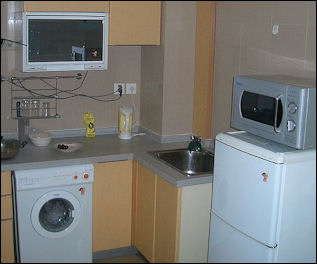
Haier apartment In the mid 2000s, a caller to The Rush Limbaugh Show complained that as he was driving past the Haier plant in Camden, South Carolina. the Chinese flag was flying higher than the American flag and the South Carolina state flag out front. It was an easy mistake to make by anyone looking at the three equal-height flagpoles from an angle. Conservative media joined in and called for protests, and the public rang the factory to complain. The Chinese executives at Haier had no idea flags were such a big deal.The complaints continued until 2008 ago when Haier America factory president Joseph Sexton, who was new to the job, decided to fix it. He had two of the poles lowered so that the U.S. flag looks highest from all angles.
It took Haier some time to work through other issues. “Having a Chinese manager didn't work. That's why they took all the Chinese managers out of here,” Haier's human resources director, Gerald Reeves told Fortune. Reeves was one of the first hired by Haier and guided the Chinese through the realities of American-style personnel management — including convincing them that they needed to offer health insurance.
What was perhaps most startling about the Haier factory was that it is actually shipping goods back to China. Best known for its mini-fridges for dorm rooms and studio apartments, Haier's U.S. plant also makes large units, good for supersized American McMansions but too large for a typical Chinese household. Now a growing number of wealthy people in China want to supersize too, so Haier has realized it can ship a small number, maybe 4,000 a year, of its highest-end refrigerators home and sell them for $2,600 apiece.
Image Sources: 1, 2) Cgstock http://www.cgstock.com/china ; 3, 4) Nolls China website http://www.paulnoll.com/China/index.html; Wiki Commons; Wiki Commons
Text Sources: New York Times, Washington Post, Los Angeles Times, Times of London, National Geographic, The New Yorker, Time, Newsweek, Reuters, AP, Lonely Planet Guides, Compton’s Encyclopedia and various books and other publications.
Last updated May 2022

